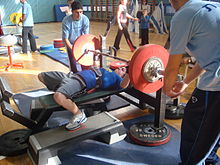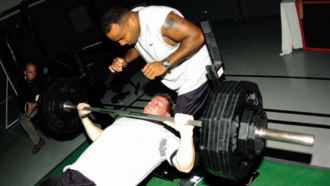Bench press
This article needs additional citations for verification. (October 2013) |


The bench press is an upper-body weight training exercise in which the trainee presses a weight upwards while lying on a weight training bench. The exercise uses the pectoralis major, the anterior deltoids, and the triceps, among other stabilizing muscles. A barbell is generally used to hold the weight, but a pair of dumbbells can also be used.[1]
The barbell bench press is one of three lifts in the sport of powerlifting alongside the deadlift and squat, and is the only lift in the sport of Paralympic powerlifting. It is also used extensively in weight training, bodybuilding, and other types of training to develop the chest muscles.
Movement
The person performing the exercise lies on their back on a bench with a barbell grasped in both hands. They lower the barbell to chest level, then press the barbell upwards, extending the arms until the elbows are locked out. This is one repetition (rep).
Powerlifting: Take position on a flat bench with body weight resting on buttocks and upper traps having an arched back and feet driven into the floor. Movement requires the weight to be taken at full arms' length, lowered to upper torso, paused, and then lifted to starting position.
History
The bench press has evolved over the years, from floor, bridge, and belly toss variations to the methods used by bodybuilders and powerlifters today. It become popular from the late 1950s onwards.[2] Despite the fact the parallel dip is safer (the dip does not require spotters, or safety bars[2]), in the 1950s the bench press took over the dip in popularity, and became the standard fare for chest exercises.[2]
At first the strict floor press was the most popular method. In 1899, using a barbell with 48 centimetres (19 in) discs (plates), George Hackenschmidt, inventor of the barbell hack squat, rolled a barbell over his face (which was turned to the side) and performed a strict floor press with 164 kilograms (362 lb). This stood as a record for 18 years until Joe Nordquest broke it by 1 kilogram (2.2 lb) in 1916.
Around this time, new methods started gaining ground. Lifters started figuring out that strong glutes could help them get the bar from the ground to overhead. They would lie on the floor and position the bar over their abdomen, then perform an explosive glute bridge movement, catapulting the bar upwards and catching it at lockout.[3]
Lifting techniques, training and drugs have improved over the years and the bench press record lift has grown from 164 kilograms (362 lb) to 501 kilograms (1,105 lb) (equipped, record held by Will Barotti) in approximately 100 years.[4]
The bench press is used as a test of upper-body explosive strength during the NFL combine, where prospective NFL draft picks attempt to get as many reps of 225 lbs as possible.[citation needed]
Muscles

A conventional bench press uses the pectoralis major, anterior deltoids, and coracobrachialis muscles to horizontally adduct the shoulder. It also uses predominantly triceps and anconeous to extend the elbows. Wider hand spacing places a greater emphasis on shoulder flexion and narrower hand spacing utilizes more elbow extension. Because of this, wider hand spacing is associated with training the pectorals and narrower hand spacing is associated with training the triceps.
In addition to the major phasic (dynamic) muscles the bench press also uses tonic (stabilizing) muscles: scapular stabilizers (serratus anterior, middle and inferior trapezius), humeral head stabilizers (rotator cuff muscles), and core (transverse abdominis, obliques, multifidus, erector spinae, quadratus lumborum)
Variations
Variations of the bench press involve different groups of muscles, or involve the same muscles in different ways:
- The flat bench press involves both portions of the pectoralis major muscle but focuses on the lower (sternal) head as well as the anterior deltoid muscle. The term 'bench press' on its own is assumed to refer to a flat bench press.
- An incline elevates the shoulders and lowers the pelvis as if reclining in a chair; this variation emphasizes anterior deltoids with little emphasis at the upper (clavicular) head of the pectoralis major. This variation is called the incline bench press.
- A decline bench press elevates the pelvis and lowers the head, and emphasizes the lower portion of the pectoralis major whilst incorporating shoulders and triceps.
- A reverse grip bench press utilizes an underhand (supinated) grip on the bar. A supinated grip externally rotates the humerus, which puts the shoulders in a much more favorable position for the lift, decreasing injury potential without compromising range of motion. It emphasises the clavicular head of the pectoralis major more than an incline bench press. On the eccentric phase of the lift, the bar path will create a larger arc and eventually touch a point on the chest that is lower compared to the regular bench press, because the upper arms and elbows are closer to the body and the angle between the humerus and the torso is smaller.
- A bench press performed with the hands close together ("close grip") relies on the triceps to complete the pressing motion.[3] Called the close grip bench press, this variation is best performed with arms in a near-vertical position to reduce strain placed upon the wrists, elbows and shoulders. A close grip bench press can also be performed with dumbbells or a barbell with neutral grips.
- A bench press performed with the hands far apart ("wide grip") shortens the range of motion, lessening the contribution of the triceps.
- A lifter can elect to lower the bar to nipple level, to the xiphoid process, or even further, to the abdomen. On the other hand, a lifter may lower the bar to a very high point on the chest, or even to the neck; the latter variation is called a guillotine press and emphasizes the upper pectorals.
- The bench press can be performed with various modifications to make the lifter or the weight less stable. Examples include lifting on a Swiss ball, using dumbbells instead of a barbell, or lifting with the legs on the bench or in the air
- The bench press can be performed with chains and bands, which are used to strengthen the top end of the range of motion in the movement (the "lockout") and develop explosive power in the bench press.[5]
- An "equipped" bench press is performed with a stiff, supportive shirt that allows greater weights to be used. The materials and cut of the bench shirt, as well as the skill of the lifter and the rules of performance, will determine how much additional weight can be pressed in the shirt as opposed to without it. The contrast between equipped, and unequipped (raw) bench press weights is illustrated in the progression of the bench press world records, with the record equipped lift exceeding the unequipped lift by hundreds of pounds.
- People who suffer from shoulder injuries can use a specialised barbell such as the Swiss Bar or Football Bar that allows them to hold the bar in a neutral grip, reducing the amount of external rotation on the shoulder. It also engages the shoulder more, increasing power in upper body movements. Another variation is the Hex Press in which two dumbbells are squeezed against each other, with the palms facing inwards. This puts the strain of the exercise on the triceps and inner chest rather than the shoulders. The Floor Press is another variation that puts less strain on the lifter's shoulders, due to the shorter range of motion.
Possible injuries

Performing the bench press can contribute to multiple types of injuries:
- Torn ligaments / tendons in shoulders
- Injuries to the trapezius muscle
- Elbow / wrist strains
- Cracked or broken ribs, usually the result of bouncing the bar off of the chest to add momentum to the lift or a loss of strength causing the bar to fall onto the chest
- Distal clavicular osteolysis: bone spur or erosion at the end of the clavicle. Athletes suffering from this condition should avoid doing bench presses.[6]
- Torn or damaged rotator cuff
- Pectoral muscle tear
- Death by asphyxiation by being trapped under the bar (several each year)[7]
See also
- NFL Scouting Combine#Bench press records
- Progression of the bench press world record
- Squat (exercise)
- Deadlift
- Push up
- Chin-up bar
Notes
- ^ John F. Graham (August 2000). "Dumbbell bench press". Strength and Conditioning Journal. 22 (4): 71. Retrieved 7 September 2014.
- ^ a b c McRobert (1998), p. 210.
- ^ a b Contreras, Bret (2011-12-15). "The Best Damn Bench Press Article Period". T Nation. Retrieved 2014-08-14.
- ^ "Powerlifter Will Barotti benches 1,105 pounds for a new world record". muscleandfitness.com.
- ^ "How to Bench Press like a Pro: A deep look at Bench Press Form". LIFT. Retrieved 2014-08-14.
- ^ IOC Sport Medicine Manual 2000 available in .PDF form online
- ^ "Petition Requesting Labeling of Weightlifting Bench-Press Benches to Reduce or Prevent Deaths Due to Asphyxia/Anoxia" (PDF). US Consumer Product Safety Commission. May 13, 2004. Archived from the original (PDF) on 2013-01-08. Retrieved 2014-08-14.
Sources
- McRobert, Stuart (1998). Beyond Brawn. US: CS Publishing Ltd. ISBN 9789963916368.
{{cite book}}: Invalid|ref=harv(help)
